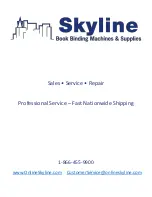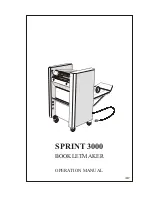
11
NORMAL OPERATION:
1. Work is deposited, from the Bookletmaker, onto
the trimmer's infeed conveyor table.
2. The infeed conveyor belts pull the work into
the trimmer.
3. As the work is pulled into the trimmer, the
work passes above photo sensor number one,
located at the end of the infeed conveyor table.
Number one photo sensor recognizes the work
and tells the control circuit that work is enter-
ing the machine.
4. The infeed conveyor throws the work over the
lower knife area and into the middle work
conveyor belts.
5. The middle work conveyour belts pull the work
over photo sensor number two, located near
the work back stop gate. Number two photo
sensor recognizes the work and tells the con-
trol circuit that work has entered the trimming
area.
6. The control circuit then lets the conveyor belts
continue to run, for a short period of time, to
allow the work to run into and square up
against the back stop gate. The conveyor belts
are then stopped.
7. At this time the control circuit energizes the
trimming clutch solenoid, which releases the
trimming clutch to begin the trimming cycle.
OPERATION
JAM DETECTION:
If the work does not finish passing over number
one photo sensor, within normal operating time,
the control circuit recognizes this as a jam. The
trimmer drive shuts off. The "PAPER JAM
WHEN LIT" indicator light becomes lit. A nor-
mally closed relay in the control panel (used as
the jam output to another machine or device)
closes.
8. The knife bar assembly begins to cycle down-
ward.
9. As the knife bar assembly cycles downward
the gate clamp begins to squeeze, flatten, and
hold the leading end (or fold) of the work.
The front clamp then begins to squeeze, flat-
ten, and hold the trim end of the work.
10. As the knife bar assembly continues down-
ward the knive begins to cut/trim the work.
11. The knife bar then begins cycling back up to
the top of it's stroke (starting position).
12. As the knife bar approaches the top of it's
stroke, it passes the knife bar proximity sen-
sor. The proximity sensor tells the control
circuit that the knife bar has reached the top of
it's stroke.
13. The control circuit then denergizes the trim-
ming clutch solenoid which stops/ends the trim-
ming cyle.
14. The control cicuit then energizes the gate so-
lenoid, which lifts up the gate, and energizes
the infeed and middle conveyor belts.
15. The trimmed work is then conveyed out of the
trimmer and deposited on the discharge table.
16. When the next work to be trimmed is sensed
by number one photo sensor (on infeed table)
the control circuit energizes the discharge table
clutch for a short time. While the discharge
clutch is energized it runs the discharge table
conveyor belts. The belts move the work on
the discharge table a short distance. The con-
trol circuit then cuts power to the discharge
table clutch. The discharge table conveyor
belts and work stop moving until the next piece
of work to be trimmed causes the discharge
table cycle to repeat.
STARTUP:
1. The "BELT DRIVE" rotary switch should be
set to "1" position.
2. Depress "POWER ON" switch to turn on
power.
3. Depress "START/RESET" switch to energize
control cicuit. The electric motor will now
energize and begin the infeed and internal con-
veyors.
4. Select "TRIMMING ON". Run the
Bookletmaker so that a booklet is deposited on
the trimmer's infeed table. The booklet will be
transported into the trimmer, trimmed, and ejected
onto the output conveyor. The output conveyor
runs for a short duration each time a booklet is
sensed entering the trimmer. This ensures that
there is no gap between work on the discharge
table.
Summary of Contents for StitchFold
Page 2: ...Trimmer OPERATION MANUAL Trimmer ...
Page 22: ...21 NOTES ...





























